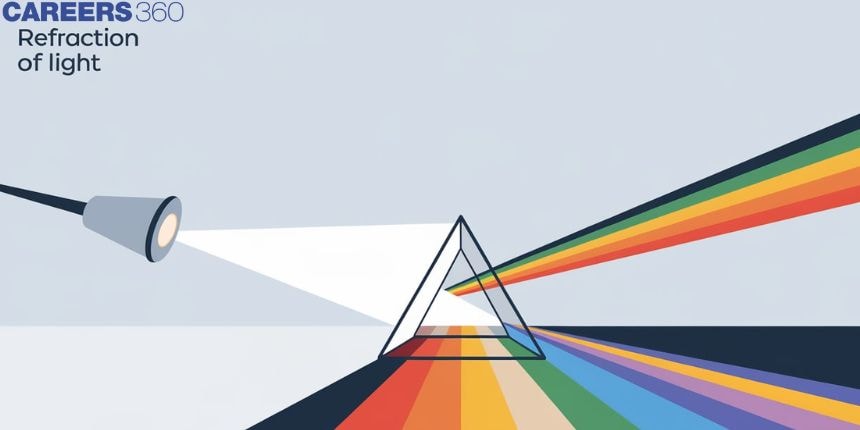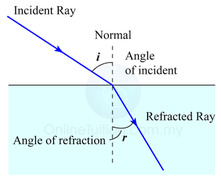Refraction of Light - Definition, Examples, FAQs
Have you ever seen a straw look like it is bent when it’s actually straight and inserted in a glass of water? This is because of the phenomenon known as refraction which refers to the change of direction of light as it moves from one substance to another. Refraction is the biggest contributor to the majority of the optical effects and is commonly seen in lenses glasses and in cameras.
This Story also Contains
- What is Refraction?
- What is Refraction of Light?
- State the laws of Refraction of Light
- What Causes Refraction?
- Refraction of Light Examples

What is Refraction?
The change in direction of a wave traveling from one medium to another caused by its change in speed is known as refraction in Physics. In deep water, for example, waves travel faster than in shallow water. Sound waves travel faster inside of the warm air than in cold air.
What is Refraction of Light?
The ray of light bends towards normal when moving from a rarer to a denser medium, and away from normal when moving from a denser to a rarer medium.
The direction of a light ray changes when it strikes the surface separating two media this phenomenon is called as refraction. The direction of light changes as a result of this at the interface of two distinct media.
The incident light's frequency remains constant, but its speed and wavelength fluctuate. When a light beam enters a denser medium, it bends closer to the normal, whereas it shifts away from the normal in a lighter medium.
Also read -
State the laws of Refraction of Light
Refraction follows two basic laws:
- Snell's law
- The Angle of Refraction is dependent on the refractive indices of the two media

Snell's Law
Snell's Law provides the mathematical relationship between the angles of incidence and refraction when light passes from one medium to another.
$$
\frac{\sin \left(\theta_1\right)}{\sin \left(\theta_2\right)}=\frac{n_2}{n_1}
$$
Where:
- $\theta_1$ is the angle of incidence (the angle between the incident ray and the normal)
- $\theta_2$ is the angle of refraction (the angle between the refracted ray and the normal)
- $n_1$ is the refractive index of the first medium (where the light is coming from)
- $n_2$ is the refractive index of the second medium (where the light is entering)
The Angle of Refraction is dependent on the refractive indices of the two media
The refractive index (denoted as n) of a material helps us to understand how much the light will slow down when it enters that material.
- If a material has a high refractive index, it means light moves more slowly in that material.
- If a material has a low refractive index, light moves faster in it.
What Causes Refraction?
When a light beam is incident on the interface of two mediums, its frequency (v) remains constant. Light, on the other hand, travels at various speeds in different materials.
$$
c=v \lambda
$$
As a result, the wavelength ($\lambda$) of light at the interface varies. This, in turn, generates refraction, or a shift in direction. During refraction, it is clear that
The frequency of light does not change. The incident light deviates due to changes in light speed and wavelength.
Refraction of Light Examples
A Straw in a Glass of Water
What Happens: Try inserting a straw into a glass containing water and observe the straw looks like it has been bent at the midline in the water's surface.
Why: Light travels faster in air than in water, therefore when the light is passing from air into water (and /or from water into air), the light bends. This bending gives a glass straw the appearance of being bent at the banks of a given water body.
Seeing a Fish Underwater
What Happens: Sometimes due to reflection image of the fish may be displaced toward the surface and, therefore, appears to be closer to the observer’s eye than it actually is.
Why: When light rays are passing through one medium to another they are refracted or bent away from the normal. This bending makes the fish be seen in a position other than the real position of the fish.
Pencil Looks Like It Broke in the Water
What Happens: If you immerse a pencil into a glass of water you appear to be able to see the pencil as broken in the middle of the water's surface.
Why: Light waves slow down as they enter the water thus hitting the water's surface the pencil looks like it is bent but in a real sense it is not.
Frequently Asked Questions (FAQs)
It's tough to photograph a fish swimming in water due to light refraction.
The reason for this is that the light beams that travel from the fish to the shooter curve at the water-air boundary. As a result, the shooter only sees a picture of the fish, not the actual creature
On a hot summer day, the air directly above the road surface is extremely hot, whereas the air at higher elevations is cool.
The refractive index of air increases with density, as we all know.
As a result, the colder air towards the top has a higher refractive index than the hotter air near the road.
The hotter, thinner air goes faster than the cooler, denser air above it.
The temperature drops with height on hot days.
As a result, the refractive index of air rises with altitude.
An optical fibre is a very thin glass or plastic fibre with a radius of around a micrometre (10-6 m).
A light pipe is formed by a group of such tiny fibres.
When a light ray is incident perpendicular to a surface's interface, it does not deviate.
When a light beam strikes a surface at a greater than critical angle, it does not refract but instead reflects back into the original medium.
The temperature of the surrounding air changes as a result of the campfire's heat convection.
This causes a constant change in the density and refractive index of air.
The refractive index of air changes with time, changing the refracted path of light ray